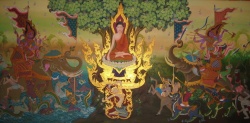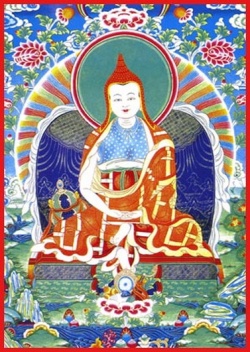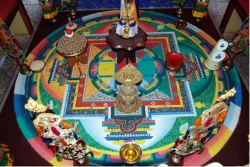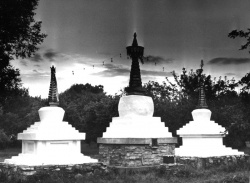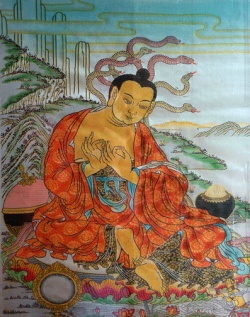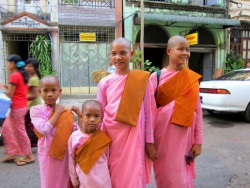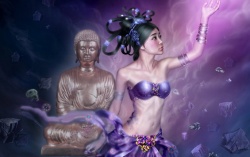The 3000 Spiritual Aspects in a Single Thought
The Great Calm-Observation, Volume 5, Part 3, Page 1
1. Observing the Mind and the Inconceivable Sphere1
This sphere is difficult to explain. First we will clarify that which is conceivable. This will make the inconceivable sphere easier to reveal.
A. That Which is Conceivable
The Small Vehicle also teaches of all things being born from the mind, causing there to be the cause and effect of the six paths and the wheel of the threefold realm3. In rejecting that which is common and rejoicing in that which is noble, it follows that the lower spiritual conditions will be discarded and the higher ones will be aroused. With the cremation of the body and the wisdom of extinction there are the Four Truths4 which are all conceivable.
The Great Vehicle also clarifies all things being born from the mind, causing there to be the ten spiritual realms. When observing the mind there is both good and evil.
There are three kinds of Evil, known as the cause and effect of the three roads5.
There are three kinds of Good, which are the cause and effect of competitiveness, personality and heaven
Upon observing these six, their impermanence and their birth and extinction, one observes that the mind has various different kinds of thoughts that do not remain. Futhermore, the observer and that which is observed are everywhere produced by the matrix of causality and conditions. In all that is produced by causality and conditions, there is emptiness of self8. This is the cause and effect of The Two Vehicles.
When observing this emptiness, one will fall into the duality of the two extremes, sinking into emptiness and stagnating in existence. However, upon arousing generosity and compassion, one will reenter into that which is temporary and there will be spiritual influence on things. Although reality is without a body one is temporarily created. Although reality is not emptiness one temporarily teaches of emptiness in order to influence and guide. This is the cause and effect of The Bodhisattva.
In observing this, whether one is able to deliver others or one is being delivered9, everywhere there is the middle way that is the true spiritual aspect of reality, ultimately purified of who is good or who is evil, who exists or who does not exist, who is delivered and who is not delivered. With everything ultimately being like this, there is the cause and effect of The Buddha.
These ten spiritual realms all arise from the mind and are like the steps of a ladder, leading from that which is shallow to that which is deep. Although it includes the Limitless Four Truths10 of the Great Vehicle, this sphere is still conceivable and is not the Calm-Observation being contemplated here.
B. That Which is Inconceivable
Like The Flower Garland (Avatamsaka) Sutra says:
"The mind is like a master artist, creating its various different aspects with the five aggregates of self11."
In all the worlds, there is nothing that is not created from the mind.
The 'various different aspects with the five aggregates of self' are the five aggregates of self in the ten spiritual realms described before.
There are three reasons for the counting of ten spiritual realms.
In order to explain the spiritual realm, we need suitable names for ten.
And each of these ten is a cause and an effect and does not appear mixed or confused with the others, and so we speak of there being ten spiritual realms.
And each of these ten is an entity and a spiritual realm into itself, and so we speak of there being ten.
The ten are generally referred to as 'The Aggregates of Self, The Portals of the Senses, and The Fields of Consciousness12.' Their realities are not the same.
The Three Roads of Evil are the aggregates of self, the portals of the senses, and the fields of consciousness that are evil and afflicted13.
The Three Good Paths are the aggregates of self, the portals of the senses, and the fields of consciousness that are good but afflicted.
The Two Vehicles are the aggregates of self, the portals of the senses, and the fields of consciousness that are without affliction.
The Bodhisattvas are the aggregates of self, the portals of the senses, and the fields of consciousness that are with or without affliction.
The Buddhas are the aggregates of self, the portals of the senses, and the fields of consciousness that are neither with nor without afflition.
The Great Discourse says:
"The Supreme Spirituality of the Dharma is Nirvana - it is neither with nor without affliction."
The Sutra of Limitless Meanings says:
The Buddha is beyond the elements, the aggregates of self, the fields of consciousness and the portals of the senses."
This is being beyond the aggregates of self, the fields of consciousness and the portals of the senses that are in the first nine spiritual realms.
Now, in speaking of the Buddha's existence, there are the aggregates of self, the fields of consciousness and the portals of the senses that are eternally remaining in Nirvana.
The Great Nirvana Sutra says:
In causing the extinction of impermanent form there is the attainment of the permanent form. Sensory perceptions, conceptualization, acts of will and consciousness are also like this.
The continuous stream of eternal bliss is the aggregation.
The covering mantle of mercy and compassion is the shade14.
Because there are the ten realms of the aggregates of self that are not the same, we speak of The World of the Five Aggregates of Self.
A collection of the five aggregates of self is generally called a society. Societies are not the same
A collection of the aggregates of self on the three roads of evil is a sinful and suffering society.
A collection of the aggregates of self in the realm of personality or heaven is a society that feels contentment.
A collection of the aggregates of self without affliction is a truly noble society.
A collection of the aggregates of self with kindness and compassion is a society of great saints.
The collection of the aggregates of self that is eternally remaining is the ultimately honored society15.
The Great Discourse says:
"The supreme society is that of the Buddha. Could it be the same as that of the ordinary people below?"
The Great Nirvana Sutra says:
"There are different names for the time of emerging from the womb16 and the time of death.
There are different names for times of sprouting and fruition."
In simply outling the one time, there are ten periods of times can be distinguished. Are the ten spiritual realms of societies any different? Because of this, we speak of The World of Societies.
The place where these ten kinds of society dwell is called the World of Countries & Lands.
Those in hell dwell on red-hot iron.
Animals dwell on earth, water and wind.
Asuras dwell on the ocean floor.
People dwell on the earth.
Gods dwell in palaces17.
Bodhisattvas of the Six Perfections18 dwell on the earth, just like people.
Bodhisattvas of the General Doctrine19, whose confusions are not yet exhausted, dwell in the same places as people and the gods. Those that are eliminating their confusions dwell in the land of ways and means20.
Bodhisattvas of the Specific Doctrine and the Total Doctrine21 that have not yet eliminatted their confusions dwell in the same places as people and gods as well as in the land of ways and means. Those that have eeliminated their confusions dwell in the land of the real reward22.
The One That Has Come dwells in the land of the serene light23.
The Sutra of the Benevolent Kings says:
"Those of the three virtuous stages and the ten noble stages24 dwell in the land of the real reward, but only the Buddha dwells in the Pure Land."
Because there are these various different kinds of lands that are not the same, we speak of The World of Countries and Lands.
These thirty kinds of distinctions25 are all completely created from the mind.
Footnotes:
1. The Inconceivable Sphere: Also called the Inconceivable Object, it is the sphere of spiritual truth or reality
2. All things: (S. Sarva dharma) All mental or spiritual phenomena, all aspects of the mind or spirituality
3. Cause and effect: karma and retribution The six paths: From realm from hell to heaven - see The Saha World.
The Threefold Realm: the realm of mortal self-existence - the three realms being those of desire, form & formlessness
4. With the cremation of the body and the wisdom of extinction there are the Four Truths:
The Four Truths of Birth & Extinction, the most basic level of understanding the Four Truths, calling for the annihilation of the ego, the false self.
See the Four Doctrines.
5. The Three Roads: Of evil: Hell, Brutality & Hunger
6. Competitiveness, personality and heaven: Here, literally, the realms of the Asuras, Humans, and Gods
7. Upon observing these six: During introspective meditation; that is, upon observing these spiritual conditions in one's own life experience
8. In all that is produced by causality and conditions, there is emptiness of self:
The understanding of the Four Truths Without Birth or Extinction (again, see the Four Doctrines), and the selflessness of absolut spiritual reality. All things are seen to be devoid of any real or substantial self in the empty space of the spiritual realm.
9. Whether one is able to deliver others or one is being delivered:
Deliverence here refers to being ferried across the stream that separates Life & Death (Samsara) from the other shore (Nirvana).
10. The Limitless Four Truths: (See the Four Doctrines) The Four Truths at the level of the Bodhisattvas who remain and work in the temporary (conceivable) world in order to deliver others
11. The Five Aggregates of Self: Physical Form, Sensory Perception, Conceptualization, Acts of Will & Consciousness; the constituents whose continuity creates the illusion of a real and substantial self
12. The (5) Aggregates of Self: (S. Skandha) As described above
The (12) Portals of the Senses: (S. Ayatana)
The Six Sense Faculties:
Eyes,
Ears,
Nose,
Tongue,
Body,
Thinking Mind
The Six Sensations: Sights, Sounds, Smells, Tastes, Contacts, Dharmas (Realities)
The (18) Fields of Consciousness: (S. Vijnana) The six fields of consciousness derived from the twelve above
13. Afflicted: Afflicted with emotional distress
(S. Klesas) and the four Asravas, the four currents of Life & Death: ignorance, desire for sensory gratification, craving for self-existence, and attachment to views (opinions).
14. In Chinese there are two translations of the Sanskrit word 'Skandha': One is 'aggregate', as in constituents that are clumped or combined together to create a self, a sentient being. The other is 'shade' or 'shadow' as in something that covers the light. This second one is the same Chinese character that is used in Taoism for 'Yin' (the shaded part of the mountain, the passive force, the centripetal energy) as opposed to 'Yang' (the sunny side, the active force, the centrifugal energy).
15. Ultimately Honored Society: That of the Buddhas
16. The time of fetus in the womb, the prenatal period (S. Kalala)
17. Those of the lower destinies live among the four elements - earth, water, wind & fire (with red-hot iron referring to fire). The reference to the ocean floor refers to the realm of turbulence, which can refer to the currents of the oceans or the atmospheres (the Asuras dwell in the realms of turbulence). The Gods dwell in the palaces - the ethereal realms of contentment and serenity.
18. Bodhisattvas of the Six Perfections: Bodhisattvas in the Doctine of Birth & Extinction (also known as 'The Three Baskets') where the laws of karma and retribution operate at their most basic level and Nirvana is defined as the annihilation of the self - see the Four Doctrines
19. Bodhisattvas of the General Doctrine: Bodhisattvas in the Doctrine without Birth or Extinction, where the principle of emptiness or transcendence is emphasized - see the Four Doctrines
20. The Land of the Ways & Means: One of The Four Lands along the spiritual path, a land common to those of the three vehicles, where the residents transcend the Threefold Realm and cultivate an understanding of emptiness (transcendence) and work to eliminate their improper views and motives.
21. Bodhisattvas of the Specific Doctrine: The teaching exclusive to the Bodhisattvas, explaining the different aspects of the temporary and provisional teachings (on the different kinds of spiritual sicknesses and medicines) and the Total Doctrines: The highest teaching, revealing the ultimate purpose of all the teachings.
See The Four Doctrines
22. The Land of the Real Reward: The land exclusive to the Bodhisattvas;
see The Four Lands.
23. The Land of the Serene Light: The land of the Buddhas;
see The Four Lands
24. The Three Virtuous Stages: The ten abodes of inspiration, the ten practices of virtue (Paramitas), and ten devotions (Parinamanas)
The Ten Noble Stages: The ten groundings (Bhumis), or final Bodhisattva stages; see the forty-two stages of the Bodhisattva path
25. Thirty kinds of distinctions: The ten spiritual realms on the levels of the individual, the society and the land

